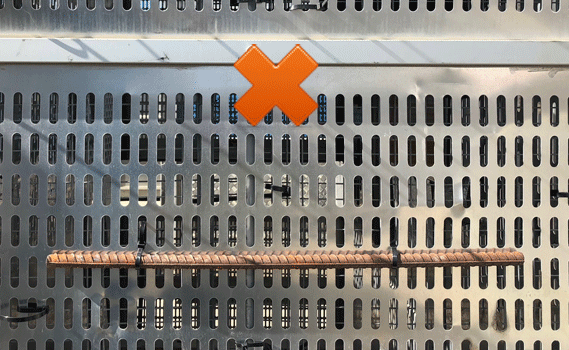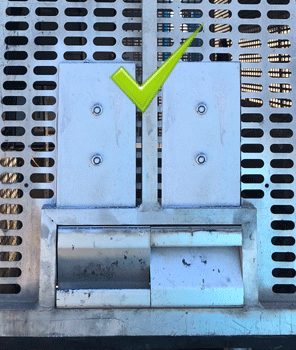Falling objects from personnel and material hoists
Issued: 03/07/2018
Last Updated: 03/07/2018
Purpose
The purpose of this alert is to highlight the risk of falling objects when zip ties (cable ties) are used to attach weights to the outside of personnel and material hoist cars. The same principles apply wherever zip ties are being used to secure parts where there is a risk to people from falling objects.
Background
In May 2018, a piece of 16 millimetre steel re-enforcement bar fell from a personnel and material hoist car on a construction site at the Gold Coast. Polycarbonate panelling, originally attached to the car, had been removed to allow for air flow through the car. After removing the panelling, the doors were no longer balanced and difficult for the hoist operator to close. To balance the doors, a steel weight was zip tied to the outside of one of the doors. It appears that the zip ties failed, allowing the bar to fall to the ground.
 Photograph 1: Unsafe tie bar attached to the hoist doors with zip ties. |
 Photograph 2: Example of an acceptable way to attach a weight to a hoist car door. |
Contributing factors
Zip ties should not be used to secure critical components where the consequences of failure are severe. While some zip ties may be rated for tensile (pulling) loads, they are not designed to resist shear (cutting) loads. Some zip ties may be made from UV resistant materials but like most plastics, they will eventually degrade in sunlight and become brittle and fail over time. Zip ties used to secure weights on hoist car doors are subject to shock loads every time the doors are closed. Failure can be rapid without warning.
Action required
Zip ties should not be used to secure weights or components to the outside of personnel and material hoists or any other plant where the weight can pose a risk if it becomes detached.
If weights are attached to hoist car doors, refer to the hoist manufacturer instructions. In the absence of manufacturer instructions, a competent person should specify the method of attaching the weight to the car, based on sound engineering principles.
The use of through bolts, passing through the weight and the car door, with a nut on the opposite side of the door is a preferred alternative. Where bolts are used the nut should be prevented from loosening by the use of an effective locking system. Photograph 2 shows an example of an acceptable way to attach a weight to a hoist car door.
Further information
Further information can be obtained from the following: